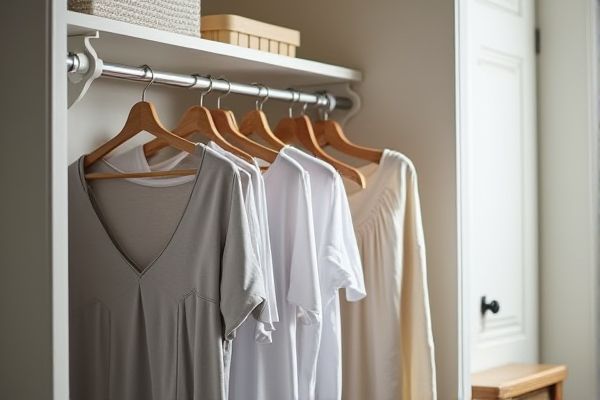
Closet rods offer sturdy, permanent support for hanging heavy laundry, while tension rods provide a flexible, easy-to-install solution ideal for temporary or lightweight drying. Discover which option best suits your laundry needs by reading the rest of this article.
Table of Comparison
| Feature | Closet Rod | Tension Rod |
|---|---|---|
| Installation | Permanent, mounted with screws | Temporary, pressure-mounted without tools |
| Weight Capacity | High, supports heavy laundry loads | Medium, limited by tension strength |
| Material | Metal or wood rods, durable | Typically metal or plastic, flexible |
| Space Usage | Fixed location, uses closet space | Adjustable length, fits various spaces |
| Cost | Moderate to high | Low to moderate |
| Best Use | Long-term laundry hanging and closet organization | Temporary or rental-friendly laundry hanging |
Closet Rod vs. Tension Rod: Key Differences
Closet rods offer sturdy, permanent support for heavy laundry loads and are typically mounted between closet walls, providing long-term durability and stability. Tension rods rely on adjustable pressure between two surfaces, making them easy to install without hardware but less suitable for heavy or bulky laundry items. Your choice depends on the weight of your garments and installation flexibility, with closet rods preferred for durability and tension rods for temporary or light-duty hanging.
Installation Process Compared
Closet rods require secure mounting with brackets screwed into walls or closet panels, offering a permanent and sturdy solution for laundry hanging. Tension rods rely on adjustable spring tension to fit snugly between two surfaces without tools or hardware, enabling quick and damage-free installation. The installation process of tension rods is faster and less invasive, while closet rods provide greater weight capacity and long-term stability.
Weight Capacity and Durability
Closet rods typically offer higher weight capacity and greater durability due to their fixed installation and robust metal construction, making them ideal for hanging heavy laundry loads. Tension rods, while convenient and easy to install, generally support lighter weights and may bow or slip under substantial pressure, reducing their reliability for heavy or frequent use. Choosing a closet rod ensures long-term sturdiness and consistent performance for laundry hanging needs.
Best Applications for Closet Rods
Closet rods are best suited for permanent laundry hanging solutions where sturdy support for heavy garments like shirts, coats, and pants is required, offering reliable weight capacity and lasting durability. These rods are ideal for walk-in closets, laundry rooms, or utility spaces where a fixed installation is preferred for easy organization and accessibility. Unlike tension rods, closet rods provide a more secure and stable option for long-term use in high-traffic laundry areas.
Ideal Uses for Tension Rods
Tension rods are ideal for temporary or lightweight laundry hanging, especially in small spaces like apartments or dorm rooms where permanent fixtures are not possible. They work best for drying delicate items, hanging lightweight clothing, or creating a portable drying solution in bathrooms or laundry rooms. Their adjustable length and easy installation make them a versatile option for renters or those needing flexible drying options.
Space-Saving Solutions: Which Rod Wins?
Closet rods provide a sturdy, permanent laundry hanging solution, ideal for maximizing vertical space in dedicated laundry rooms or closets. Tension rods offer versatile, adjustable placement in compact areas without installation, perfect for renters or temporary setups where space-saving flexibility is key. When prioritizing space efficiency, tension rods excel in adaptability, while closet rods ensure consistent capacity and durability.
Cost Comparison and Value
Closet rods typically involve a higher upfront cost due to materials like metal or wood and require professional installation, making them a longer-term investment with greater durability and stability for heavy laundry loads. Tension rods are more affordable, usually made of lightweight metal or plastic, and require no tools or permanent fixtures, offering flexible and temporary solutions perfect for light to moderate laundry hanging. Your choice depends on balancing budget constraints with the need for strength and installation permanence, with tension rods providing excellent short-term value and closet rods offering enhanced long-term utility.
Versatility and Adjustability
Closet rods offer sturdy, fixed support ideal for heavier laundry loads and long-term installation, ensuring consistent weight capacity. Tension rods provide exceptional versatility and adjustability, allowing for quick resizing to fit various spaces without tools or permanent fixtures. Their easy installation and repositioning make tension rods a practical choice for temporary or flexible laundry hanging needs.
Style and Aesthetics
Closet rods offer a sleek, built-in look that seamlessly integrates with your laundry space, providing a polished and organized aesthetic. Tension rods, while versatile and easy to install, tend to have a more temporary appearance that can disrupt the visual flow of your room. Your choice between these rods will impact the overall style and cohesiveness of your laundry area, balancing permanence against adaptability.
Choosing the Right Rod for Your Laundry Needs
Choosing the right rod for your laundry needs depends on durability, weight capacity, and installation preferences. Closet rods offer strong support for heavier loads and long-term use, making them ideal for large laundry spaces or heavy garments. Tension rods provide quick, tool-free setup and adjustable length, perfect for temporary spaces or small laundry areas where convenience and flexibility are priorities.
 homyna.com
homyna.com